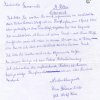The forced labor camp in Viehofen
The fact that in Viehofen near St. Pölten a forced labor camp for Hungarian Jews and Jewish women existed, was for more than 60 years displaced and forgotten. It was not until the letter of a young youth, Rószi Wolf, to the INJOEST, that it was known that Jewish families were used as slaves for the management of traits in Viehofen. From 10 July 1944 to 8 April 1945 up to 180 people aged two to over 80 years lived in three barracks and huts.
Nearby, the Glanzstoff-Werke operated a warehouse for non-Jewish forced laborers. The inmates of both camps suffered from lack of hygiene, cold, exhaustion, and hunger. Bold residents laid potatoes in the grass for them. To date, eight Jewish victims have been known, and they rest in an anonymous mass grave in Row VI, Schachtgrab 19, at the main cemetery of St. Pölten. Rózzi's father, Armin, whose grave she asked in the letter, died in the Au during a bomb attack on a heart attack. The prisoners were not allowed to enter the air-raid shelter.
Just before the end of the war, the camp inmates were driven into the Mauthausen concentration camp. Like many other elderly and sick, Rószis mother Julia did not survive this death march. The camp doctor Dr. Ernst Balog was hiding with his family in the St. Pöltner hospital by the spiritual sister Andrea (Ursula Skafar). Also the families Partos and Kraus with the baby born in the camp survived by non-Jewish helpers. After the war the forced labor camp fell into oblivion. The "great lake Paderta" was created by the removal of the gravel from 1966 to 1985. Today the Viehofen lakes are a popular recreation area.





